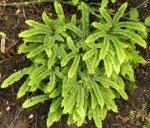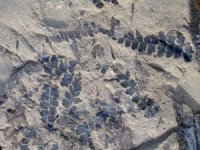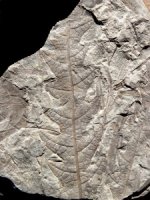 (I)
(I)
Marattia-like ferns
These ferns, together with the adder's tongue-like ferns, used to be counted
among the so-called eusporangiate ferns. These are ferns with relatively
large sporangia with thick walls, producing many spores. The remaining ferns
belong to the leptosporangiate ferns, characterized by a small, stalked and
thinwalled sporangium containing a much smaller number of spores.
Marattia-like ferns still occur in the tropics and are confined to
the southeast of Asia.
The most well-known representative of this group is the tree fern
Psaronius. Beautiful
silicified trunks of this tree have been found, among others in the region
of Chemnitz (Germany) where they date from the Early Permian (290 million
years).
 On the right
is a reconstruction of the tree (click on the picture). The leaves are mostly
found separate from the trunks, in different layers. They are called
Pecopteris and they are characterized by the fact that the leaflets
of the last order, the pinnules (see below for the term), are feather-veined
and are broadly attached to the axis.
On the right
is a reconstruction of the tree (click on the picture). The leaves are mostly
found separate from the trunks, in different layers. They are called
Pecopteris and they are characterized by the fact that the leaflets
of the last order, the pinnules (see below for the term), are feather-veined
and are broadly attached to the axis.

 Marattia-like fossils occur also in Jurassic sediments. An example
is shown in the picture on the left (click on it): it is a part of large
compound leaf found in the region of Bayreuth (Germ.). The age is about 200
million years (lowest Jurassic).
Marattia-like fossils occur also in Jurassic sediments. An example
is shown in the picture on the left (click on it): it is a part of large
compound leaf found in the region of Bayreuth (Germ.). The age is about 200
million years (lowest Jurassic).
A species is also reported from the famous fossil flora of North-Yorkshire.
This one is aged about 150 million years (Middle Jurassic). The resemblance
between this fossil and the extant ones is so striking that it is justified
to use the genus name Marattia also for the fossil.
Adder's tongue-like ferns
This group is also called Ophioglossales after the Latin name
Ophioglossum for adder's tongue. Also the moonwort (Botrychium)
and some other genera are members of this group.
The plants have in most cases an undivided leaf and a separate spore spike.
They grow in moderate and cold areas and form only a small group. This was
the same in the past. Only very few fossils of this group have been found.
The oldest among them date from the Paleocene (60 million years): thus relatively
young.
Leptosporangiate ferns
As said before, most of the living species belong to this group: about 11,500
species divided over 300 genera. Most of these ferns have pinnate leaves,
but a few have undivided ones. The sporangia are always united in sori.
There are too many groups to describe here, but I'd like to say something
about some of them of which also fossils have been found.
Osmundales
An ancient order is the one of the Osmundales or the royal ferns. This one
is going back to the Permian (250 - 200 million year).
 There are still
three extant genera in this group: Osmunda (royal fern), Todea
and Leptopteris with
There are still
three extant genera in this group: Osmunda (royal fern), Todea
and Leptopteris with
 together
16 species, whereas there are 150 fossil species known. An example of such
a fossil is Todites from the Jurassic of North-Yorkshire (photo on
the left). Cladophlebis (photo on the right) from the same area has
leaflets resembling very much those of Todea. Possibly these are the
sterile leaves of Todites.
together
16 species, whereas there are 150 fossil species known. An example of such
a fossil is Todites from the Jurassic of North-Yorkshire (photo on
the left). Cladophlebis (photo on the right) from the same area has
leaflets resembling very much those of Todea. Possibly these are the
sterile leaves of Todites.
From the Cretaceous (70 million years) fossils have been found resembling
the modern royal ferns so much, that they are are incorporated in the still
living genus Osmunda.
It seems that the dimorphism in the royal fern (sterile leaves
and separate spore spikes) has come into existence only rather recently.
Tempskyaceae  This
is an extinct family of ferns with a 'false trunk'. It is composed of a great
number of branching tiny stems, embedded in the surrounding adventitious
roots (air roots). This
is an extinct family of ferns with a 'false trunk'. It is composed of a great
number of branching tiny stems, embedded in the surrounding adventitious
roots (air roots).
 Not, like in
other fern trees, a real trunk surrounded by a root mantle , but frequently
branching stems with aerial rootlets filling up the space between the stems.
The photo on the right shows a piece of such a root mantle with a stem and
many rootlets. The picture on the left is a well-known reconstruction of
the
Tempskya-'tree'. Not, like in
other fern trees, a real trunk surrounded by a root mantle , but frequently
branching stems with aerial rootlets filling up the space between the stems.
The photo on the right shows a piece of such a root mantle with a stem and
many rootlets. The picture on the left is a well-known reconstruction of
the
Tempskya-'tree'.
This family only occurred during the Cretaceous (120 - 65 million years). |
Schizaceae  The origin of
this family probably lies in the Jurassic. The origin of
this family probably lies in the Jurassic.
 Klukia
(right) is a rather common formgenus within this group. The climbing fern
Lygodium, which has nowadays leaves without blades up to 10 m long,
is also a member of this family. The photo on the left shows a part of a
leaf of Lygodium gaudinii from the Oligocene of the south of France
(30 million year). Klukia
(right) is a rather common formgenus within this group. The climbing fern
Lygodium, which has nowadays leaves without blades up to 10 m long,
is also a member of this family. The photo on the left shows a part of a
leaf of Lygodium gaudinii from the Oligocene of the south of France
(30 million year). |
Dicksioniaceae
 In this family
of tree ferns five existing genera are distinguised among which the
In this family
of tree ferns five existing genera are distinguised among which the
 prehistoric
looking Dicksonia tree. Many of these plants have hairs and scales
on the leaves and the rhizomes (i.e. the horizontal growing subterranean
axes). The sori can be situated near the margin of the leaf, but in other
species they are covering the whole back of the leaf.
prehistoric
looking Dicksonia tree. Many of these plants have hairs and scales
on the leaves and the rhizomes (i.e. the horizontal growing subterranean
axes). The sori can be situated near the margin of the leaf, but in other
species they are covering the whole back of the leaf.
Fossils of these plants are known from the beginning of the Jurassic (200
million years).
Examples of fossils are Coniopteris (left) and Eboracia (right)
from the Middle Jurassic of North-Yorkshire (150 million years).
 Matoniaceae Matoniaceae This family still contains two extant genera: Matonia and Phanerosorus. The leaves of Matonia are composed like palm leaves. In the Mesozoic plants of this family were rather common, but only with a limited number of species. An example is the genus Phlebopteris (photo on the right) from the Lower Jurassic of the Bayreuth region (200 million years). |
Dipteridaceae  Two
genera remain nowadays from this family: Dipteris (11 species) and
Cheiropleuria (1 species). The leaves often show a reticulate venation,
reminding somewhat of modern flowering plants. An example of a fossil is
Dictyophyllum (photo on the left) from the Lower Jurassic of Bayreuth
(200 million years). Two
genera remain nowadays from this family: Dipteris (11 species) and
Cheiropleuria (1 species). The leaves often show a reticulate venation,
reminding somewhat of modern flowering plants. An example of a fossil is
Dictyophyllum (photo on the left) from the Lower Jurassic of Bayreuth
(200 million years). |
Polypodiales
This order, named after the polypodies (Polypodium), includes many
known genera and goes back till into the Cretaceous. About 80% of all now
living ferns belong to this group, which is considered to be one of the most
'modern' ones. In the root mantle of the tree fern Tempskya from the
Upper Cretaceous (90 million years) rootlets have been found of a fern from
this family.
Salviniales
Very few fossils of these water ferns are known. They originate possibly
from the late Cretaceous (80 million years).
Conclusion
Within the group of the true ferns three radiations (periods of coming in
existence of new types) occurred in the course of time.
- in the Paleozoic: especially during the Carboniferous many new groups came
into existence
- in the Late Permian and the Early Triassic: before and after the great
extinction at the end of the Permian (250 million years) many of the modern
families developed
- in the Late Cretaceous and the Paleocene: before and after the great extinction
at the end of the Cretaceous (65 million years) the advanced modern families
and the modern genera appeared. This development was more or less synchronic
with the rise of the flowering plants (angiosperms). It is certainly possible
that new niches were created as a consequence of the changes, which offered
possibilities for new fern species.
In most cases ferns have been of modest importance in the history of the
flora, probably caused by their dependence of humid habitats. Still, there
has been a period during which they were quite dominant. This was directly
after the impact of the huge meteorite at the end of the Cretaceous (65 million
years ago). Research on fern spores and pollen has revealed that ferns have
covered the whole earth during a period of 10,000 to 100,000 years. Afterwards
the flowering plants took the lead again.
Literature
Taylor, T.N., Taylor E.L. & Krings, M., 2009. Paleobotany: The Biology
and Evolution of Fossil Plants [2nd Ed]. New York: Academic Press.